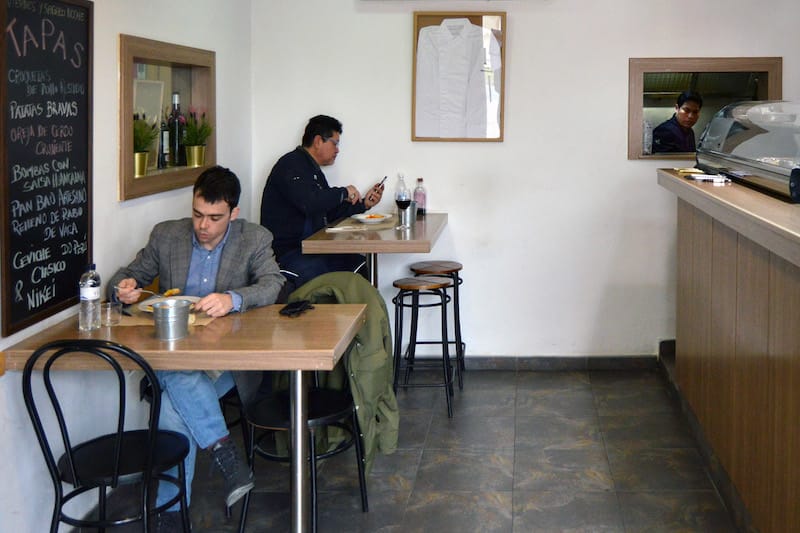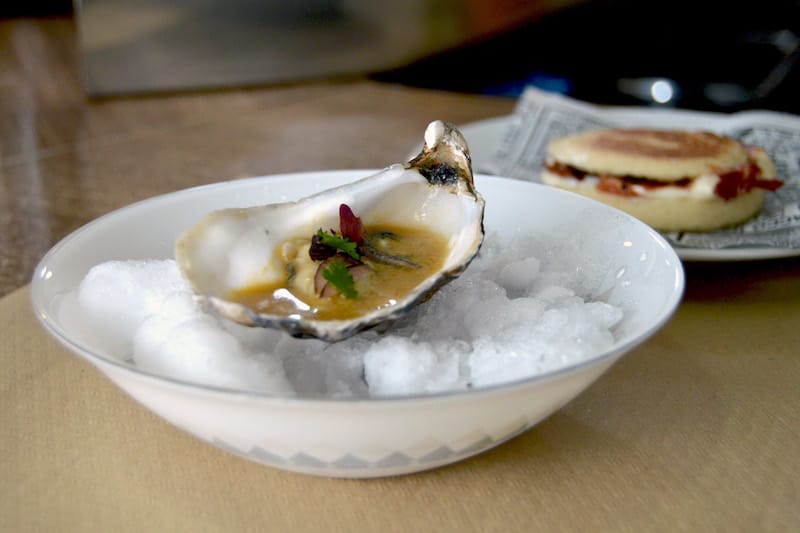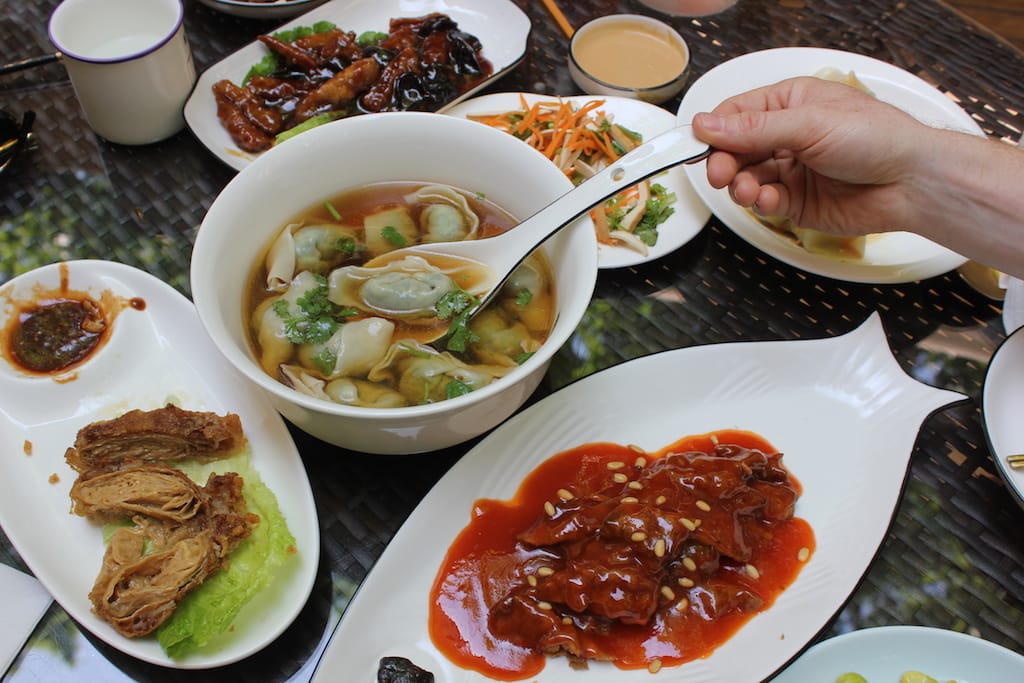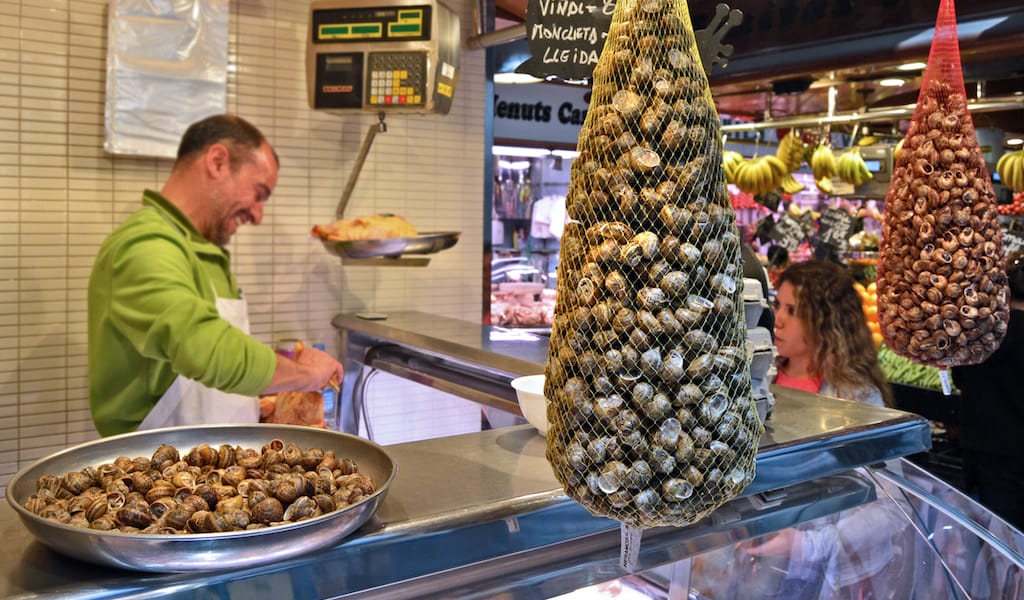Editor’s note: We regret to report that El Practic has closed.
El Practic doesn’t look like much at first glance. The small restaurant is sparsely decorated and populated by a few naked tables. Its location – in front of two massive buildings under construction in Cornellá de Llobregat, an industry-heavy city on the southwestern periphery of the Barcelona metropolitan area – is not where many people would choose to set up a restaurant.
But chef Andrés Huarcaya was certain people would come. “I’ve worked in so many places,” he said, “and one day it hit me that if you do good work – this is the key – then people will come. On this street, nobody passes by at night. And yet we are always packed on Fridays and Saturdays – totally packed!”
It seems like Huarcaya takes to these frontier zones like a fish to water. Perhaps it’s because he has straddled two cultures his entire life – Huarcaya was born and raised in Perú, but has lived most of his adult life in Barcelona, where he completed his culinary training and went on to work in several top restaurants. But it may also be related to his time spent at El Bulli Catering, where he began working in 2000. This position was all about pushing boundaries: Huarcaya contributed to the development of some of the most sophisticated and cutting-edge culinary techniques at the time.

In 2008, he struck out on his own and opened the first iteration of El Practic in Ciutat de la Justícia (City of Justice), a unique nine-building architectural development that brought together most of Barcelona and l’Hospitalet’s legal departments and courts in an area far removed from central Barcelona. Amidst all these legal offices, the restaurant’s modern takes on more traditional Spanish and Catalan dishes, usually incorporating some of the tricks he learned at El Bulli, were a hit. But the impulse to grow brought him and his family, in 2013, to Sants, another peripheral neighborhood with strong connections to Barcelona’s industrial past, where he found a bigger space to develop his project – it became the location of El Practic 2.0, which was equally as popular as the original.
After a few years, Huarcaya was worn down from the grind of running his own restaurant and needed a break from the routine. So he shuttered El Practic and worked on other people’s projects in Dubai and at high-end restaurants in central Barcelona. But he began dreaming again of what he could create in his own kitchen. “When you reach maturity as a chef, after having seen so many things, you start to believe that it is possible to do something really different,” he said.
So he decided to open another version of El Practic in Cornellá, but a pared-down version this time. With a smaller space, a simpler décor and a shorter menu, Huarcaya can focus on creating imaginative food at affordable prices (he relies mainly on relatively humble, albeit high-quality products like mackerel, anchovies and pig ears). His tasting menu and daily lunch specials incorporate both Catalan and Peruvian culinary elements, and are created using a mix of traditional and contemporary techniques.
Huarcaya’s success lies in his willingness to keep the doors open to change and to remaking his restaurant from scratch again – and again.
The star of the short menu is the pig ear, an inexpensive product that reaches its full potential in Huarcaya’s kitchen – he breathes new life into this classic Spanish and Catalan dish. In his version, the pig ear is cooked twice, the first being long and slow at a low temperature (under 70 degrees C) to get the collagens to the perfect gooey point, and the second being sous-vide. The meat is then chopped into small bits, covered with a layer of sweet paprika, dressed with drops of wine reduction and peanut praline, and accompanied by an ultra fine picada of almonds, parsley and garlic. Our first bite into the tapa was heavenly – the pork was full of contrasts, crispy on the outside, tender and gelatinous on the inside, and perfectly tempered by the fresh and nutty picada and the discrete acidity of the wine reduction.
The menu also goes beyond Catalan and Spanish cuisine, drawing inspiration from all over the world, with Peru, not surprisingly, featuring most prominently. Huarcaya uses the sous-vide technique to make an excellent ceviche – this method allows the fish to absorb the tiger’s milk (the Peruvian term for the citrus-based marinade that cures the seafood in a ceviche) even more deeply, creating a real wallop of flavor. Currently they offer two ceviche options: classic ceviche and Nikkei-style (a fusion of Peruvian and Japanese cuisine) ceviche, which is only available on Saturday.

We found ourselves smitten with the Nikkei-style Galician oyster, a wonderfully expressive bite of seafood served on ice. The marinade, which consists of teriyaki sauce, sesame seeds, lemon, ginger, garlic, coriander and rocoto chile peppers, enhances without overpowering, allowing the Atlantic oyster to be herself.
Most surprising for us was the bao (steamed buns) – the pillowy dough, which Huarcaya makes in-house, is filled with Mediterranean ingredients like mozzarella and Iberian ham. In fact, all these international flourishes and nods are paired with Mediterranean ingredients. We most appreciated this intermingling as we were sopping up the leftover tiger’s milk with tomato bread, an iconic Catalan dish. (It’s fitting that Huarcaya’s business card reads: “Conexion Perú – Catalunya. Ceviche & Tomato Bread.”)
During the week, a mix of construction and office workers come in for the daily lunch menu, which is more rooted in traditional Catalan cuisine. His tasting menu of seven dishes plus dessert for 20 euros is also available during the weekday lunch service. On Friday and Saturday evenings, the restaurant is packed with Cornellá locals and Barcelonans who are willing to travel for the special weekend tapas menu, which is more creative and varied.
On our most recent visit, the first item on the tapas menu was spherical “olives,” a miracle of molecular gastronomy and a tribute to El Bulli, where the dish was developed (the spherical “olive” is actually olive juice encased in a thin membrane). As we bit into the “olive” and briny juice gushed out, we found ourselves dazzled by Huarcaya’s technical abilities. But showmanship can only go so far. What really makes him so successful is his willingness to keep the doors open to change, whether that means tweaking his best recipes or remaking his restaurant from scratch again – and again.
 July 11, 2019 Godly Vegetarian
July 11, 2019 Godly Vegetarian
If you hadn’t read the flyer closely before heading to Shanghai’s first ever MeatFest […] Posted in Shanghai May 12, 2021 Building Blocks
May 12, 2021 Building Blocks
For thousands of years, snails have been an easy source of protein, particularly during […] Posted in Barcelona December 12, 2017 Best Bites 2017
December 12, 2017 Best Bites 2017
This year saw record-breaking numbers of tourists descend on Tokyo, and a handful more […] Posted in Tokyo
Published on March 12, 2018
Related stories
July 11, 2019
ShanghaiIf you hadn’t read the flyer closely before heading to Shanghai’s first ever MeatFest last month, you might have been a bit disappointed upon arrival. The sounds and smells of sizzling meat might have seemed like a carnivore’s dream come true, but the name was tongue in cheek; the event was thrown by Vegans of…
May 12, 2021
BarcelonaFor thousands of years, snails have been an easy source of protein, particularly during lean times. But for the Romans, these slimy mollusks were more than just a back up – a meal of snails was considered an exquisite feast. The Romans were experts on the subject. They studied and classified snails; they knew where…
December 12, 2017
TokyoThis year saw record-breaking numbers of tourists descend on Tokyo, and a handful more Michelin stars to further the capital’s lead over every other city in the world. Feeling vicariously fatigued from all this attention, for the most part I tried my best to avoid both the throngs of tourists and Michelin-grade ostentation this year,…



















































































